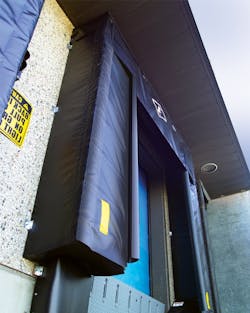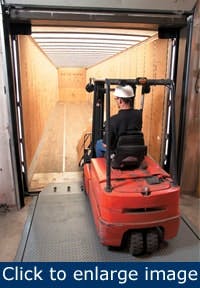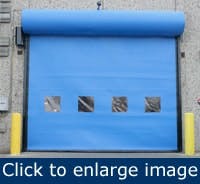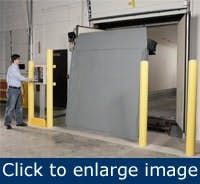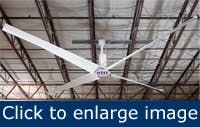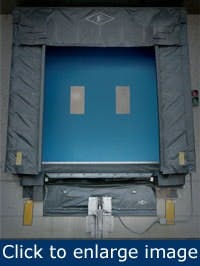Make the loading dock a more pleasant place during the cold weather
Exposed gaps around swing-out trailer doors create the equivalent of a 2 1/2 square foot hole in the dock wall that can cost a facility thousands of dollars in energy losses.
The HVAC system often needs help when it comes to saving energy and improving employee comfort at the manufacturing plant’s loading dock and other expansive areas. Here’s why environmental conditions at the dock need attention this winter, along with relatively easy and cost-effective ways to button things up.
The bottom line
A number of trends and issues affect the dock environment and its effect on a company’s energy bill. This factor is on a par with productivity and the morale of those who work there.
The goal at any dock is to move more materials safely in as little time as possible at the lowest possible cost. The ongoing trend has resulted in bigger, more expansive interior dock spaces in most industries. A larger dock, in turn, drives the need for improved climate control in an area that is traditionally challenging to heat and cool.
Installing a soft-sided shelter that incorporates hooks on the shelter’s side curtains will seal trailer door hinge gaps and prevent airflow in and out of a facility.
Many docks also serve as staging areas for raw materials and finished goods. The need for better environmental control is especially important because more comfortable employees are happier and more productive.
Large spaces and staging aside, there’s the shipping and receiving side of things. Trailers are loaded and unloaded continuously, which produces an opportunity for cold air to flow into a facility and expensive heated or cooled air to flow out. It’s also common for melting snow and ice to find a way inside if a dock isn’t properly sealed.
Ideas that work
Here are relatively easy and cost-effective ideas to make docks and other large plant areas more energy efficient and more comfortable for employees and to save tens of thousands of dollars annually in energy costs.
High-speed exterior doors offer decreased cycle times to keep costly treated air inside the plant and untreated outside the facility. An efficient door bottom seal also minimizes the potential for energy loss.
Some vertical-storing levelers feature a “drive-thru application,” which allows the truck to back up to the loading dock with its doors closed.
A single HVLS fan can cover the same area as 10 traditional floor or ceiling fans, yet it costs five to seven times less to operate
Install high-volume/low-speed (HVLS) fans to de-stratify air: HVLS fans circulate air more efficiently than traditional fans for achieving a mixing effect that produces a more uniform air temperature from floor to ceiling. Smaller, high-speed ceiling fans are ineffective at pushing trapped warm air down from the ceiling. Also, the stratified air doesn’t get mixed with the air near the floor, leaving a greater temperature differential from floor to ceiling. HVLS fans use little energy while gently moving large quantities of warm air near the ceiling back down toward the floor and into more areas where it’s needed.
{pb}Heating and cooling energy can escape through the gaps where the dock leveler, truck and dock seal or shelter all meet. Heat transfer through the steel leveler deck adds to the loss.
Seal things up: Semi trailers with swing-out doors leave gaps on either side of the trailer when they’re being loaded and unloaded. The gaps are equivalent to a 2.5-sf hole that allows air and conditioned air to flow in and out freely. Close the gaps with a dock seal or shelter that seals the trailer-door hinge gaps.
Address the dock’s underside: They’re called under-leveler seals, and they keep heated air from escaping through gaps where the dock leveler, semi trailer and dock seal or shelter meet at the bottom of the dock door opening. They also prevent the energy loss that occurs during heat transfer through the steel leveler deck.
The simple device uses a compressible vinyl sealing curtain and other components to close off the pit area beneath the leveler as well as open air gaps in leveler corners.
Close up gaps: The many gaps on the bottoms and sides of dock levelers and around the perimeter of most sectional overhead doors allow air to flow in and out of a facility. Dock leveler and door weather seals are a relatively easy and cost-effective fix.
Go vertical: Some companies use vertical-storing dock levelers to enhance a more energy-efficient dock. The leveler allows overhead dock doors to seal tightly to the pit floor when a semi trailer isn’t.
Weighted, rain-diverting header seals: Water that gets into the dock produces an uncomfortable and unsafe environment. It also can result in product damage. The problem can be addressed effectively with rain-diverting header seals. The key is to choose one that handles tall and short trailers alike, delivers the right degree of gravity-based pressure where needed and withstands repeated punishment by trailers over time.
Focus on door cycle times: A door’s cycle time (opening and closing) and the seal it provides are more important than R-value when it comes to energy efficiency. Some high-speed, roll-up doors are rated to operate as fast as 100 in./sec, leaving little time for energy to escape. A sufficiently weighted soft-bottom edge also provides a tight bottom seal.
| Source of loss | Source of energy loss | Potential annual energy savings |
| Loading dock | “Small” air gaps and exposed leveler pits | $400 to $5,000 per dock position |
| Exterior doors |
Inefficient seal and slow cycle time | $400 to $7,000 per opening |
| Freezer/cooler doors | Defrost system cost and air leakage | $5,000 to $18,000 per opening |
| Interior air movement | Inefficient heating/cooling | 20% to 30% per year |
| Total potential annual savings | $5,800 to $30,000, and more | |
Table 1. The savings for a single facility can be substantial with equipment upgrades in key areas of the facility. |
||
Frost collecting on freezer doors, or the use of heated air curtains or heat lamps to keep them clean, can indicate substantial energy losses that can total tens of thousands of dollars each year.
Take advantage of energy rebates: Many states and local utilities offer incentives and rebates for projects and upgrades that reduce energy consumption. Capitalize on them whenever possible.
Don’t put it off
The cost of energy is only expected to increase during the coming year. And there’s only so much an HVAC system can do. Act now to reduce energy demand at the plant by improving environmental conditions in and around the dock.
Walt Swietlik is customer relations manager at Rite-Hite Holding in Milwaukee. Contact him at [email protected] and (414) 355-2600.
